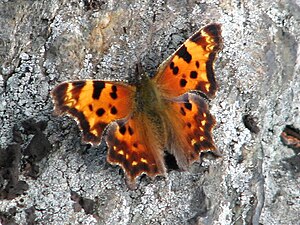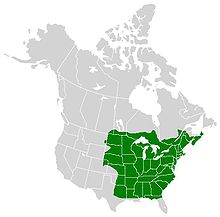Polygonia comma
| Polygonia comma | ||||||||||||
|---|---|---|---|---|---|---|---|---|---|---|---|---|

Polygonia comma , autumn generation |
||||||||||||
| Systematics | ||||||||||||
|
||||||||||||
| Scientific name | ||||||||||||
| Polygonia comma | ||||||||||||
| ( Harris , 1842) |
Polygonia comma ( Syn .: Nymphalis comma ) is a butterfly (day butterfly ) from the family of the noble butterfly (Nymphalidae).
features
butterfly
The moths reach a wingspan of 45 to 64 millimeters. The wings are jagged on the outer edge and very variable in color. The basic color depends primarily on the season. The so-called "summer generation" is brownish on the front wings and almost black on the hind wings. The “autumn / winter generation”, on the other hand, has an orange to brownish-red basic color. All butterflies are drawn with a black, brown and yellow spot pattern. The undersides of the wings are marbled in graduated brown tones. The white C-symbol in the middle is noticeable.
Caterpillar
Adult caterpillars can appear in a variety of color combinations. For example, they show green-white or yellow-white, green-brown, red-brown, pink or black tints. In addition, the thorns distributed over the whole body are white or yellow. Younger caterpillar stages are colored black in the basic shade.
Similar species
Polygonia comma is similar to many species of Polygonia , in particular:
- The C-butterfly ( Polygonia c-album ), which is native to Europe, North Africa and Asia and thus does not form any geographical overlap.
- Polygonia faunus is distinguished by a series of green dots on the underside of the hind wings.
- Polygonia interrogationis can be distinguished by a mostly interrupted C-symbol and a weaker marbling on the underside of the hind wings.
- Polygonia satyrus shows a more yellow-brown color on the upper side of the wing and colonizes predominantly western and northern areas of North America.
Geographical distribution and habitat
Polygonia comma occurs in the southeastern states of Canada and in the east of the USA and is therefore also referred to there as "Eastern Comma". The distribution extends from the Rocky Mountains to the east and south of Canada to Texas and the Gulf Coast . The animals prefer moist terrain, for example riverside areas, shady forests and moorland.
Way of life
The kind forms several generations per year. The last generation hibernates as a moth. At rest they like to sit on the ground and fold their wings upright. You then look like a withered leaf. This means that they can hardly be recognized by predators. The moths rarely visit flowers. Instead, they prefer watering holes, overripe fruit, and manure for ingesting food and minerals. The females often lay the green eggs piled on top of the food plants. The caterpillars like to live in spun nests and feed on a variety of different plants, such as the nettle family (Urticaceae), elm family (Ulmaceae) or hemp family (Cannabaceae). At hops ( Humulus ) they are rarely harmful.
swell
Individual evidence
literature
- James A. Scott: The Butterflies of North America , Stanford University Press, Stanford CA., 1992, ISBN 0-8047-2013-4
Web links
- eastern_comma.htm photos
- www.butterfliesandmoths.org Butterflies and Moths of North America
- Encyclopedia of Life Taxonomy and Photos


